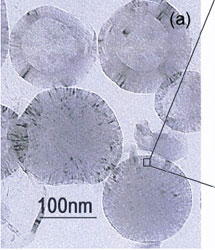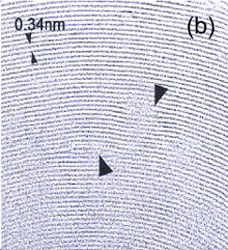Graphite is a polymorph of carbon consisting of sheets of strongly bonded hexagonal rings (graphene), the atoms being farther away from and much more weakly bound to the neighboring sheet. Each sheet is soft enough to be bent and twisted without deformation. One can, therefore, envision and realize interesting cluster features both theoretically and experimentally. One rather interesting geometry which has been made
at JAERI is carbon "onions", i.e., nesting graphitic spheres. The structure also resembles Russian Matryoshka dolls. Such an unusual material attracts scientists not only for its unique structure but also for specific applications such as solid lubricants and nanometer-scale bearings.
The transmission electron microscope interfaced with ion accelerators, which has been installed at the Takasaki Establishment (shown in Fig. 9-1) is a powerful facility allowing one to observe microstructural sample evolution during irradiation and implantation processes. We have successfully observed nucleation and growth processes of carbon onions in copper implanted with carbon ions, and have established synthesis conditions which control the size and morphology of the onions. In addition to carbon onions, we have also been able to synthesize onion-like clusters with hollow cores (Fig. 9-2), i.e., carbon nanocapsules. This substance can typically be synthesized on polycrystalline copper substrates implanted with carbon ions. Because of their isotropic morphology with a graphite base, carbon onions and nanocapsules presumably have interesting and useful properties, such as high elastic constants and low coefficients of friction. We are investigating the properties of carbon onion such as these, and are also investigating variations in the method of synthesis so as to enhance production yield. |



